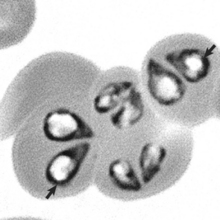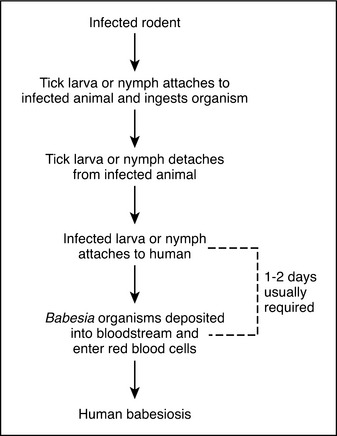BABESIOSIS
Babesiosis is a parasitic infection of red blood cells that is spread by a tick bite. The disease is also known as piroplasmosis (pirum means pear in Greek) because the parasite appears pear-shaped in red blood cells. Human babesiosis is also known as Nantucket fever because the disease was first diagnosed after an outbreak on Nantucket Island, Massachusetts.
TRANSMISSION
The deer tick life cycle takes an average of 2 years to complete. Female ticks lay their eggs on the ground in early spring. By summer, eggs hatch into larvae. Larvae prefer to feed on mice, other small mammals, and birds in the summer and early fall. They will then molt into nymphs and become inactive until spring. Cold weather (near or below freezing) inhibits tick activity. During the following spring and summer, nymphs will feed on white-footed mice or other rodents, birds, and other small mammals, and in the fall they will molt into adults. Most people are infected by nymphs. The adult ticks prefer to feed and mate on large animals, such as whitetail deer, in the fall and early spring. Female ticks then drop off of these animals and lay eggs on the ground, and a new life cycle begins (Figure 3).
After being deposited in a new host, the parasites invade red blood cells, multiply, and eventually rupture the membranes of infected red blood cells and invade other red blood cells (Figure 4).

FIGURE 4 Babesia organisms in red blood cells
(From Harvey JW: Atlas of veterinary hematology: blood and bone marrow of domestic animals, St Louis, 2001, Saunders.)
With B. microti, the tick larvae and nymphs feed primarily on the white-footed deer mouse. The adult ticks feed on whitetail deer, which do not become infected with B. microti. The adult ticks mate while they are feeding on the deer, so even though the deer do not become infected, they allow the life cycle of the tick to continue. The parasite passes from larva to nymph to adult tick as the tick matures. Human infections are accidental occurrences. Person-to-person infections, via blood transfusions and transplacental infection, have been reported.
BABESIOSIS IN ANIMALS
DOGS
The subclinical phase can last months or years. It is characterized by a balance between the Babesia organisms and the immune system of the host, so there is little clinical evidence of disease. The balance can be upset by stress, concurrent infections (especially ehrlichiosis), immunosuppression, removal of the spleen, surgery, or extreme exercise. During this phase, the dog may show only an intermittent fever and anorexia. When the balance is upset, the Babesia organisms will begin to increase in number, and the dog will move into the next phase. Greyhounds are frequently subclinical carriers of babesiosis, and they can spread the disease through blood transfusions or to their puppies transplacentally.
Stay updated, free articles. Join our Telegram channel

Full access? Get Clinical Tree



